Blog- Striking the head of God, spitting in his face.
The face of God represents intimacy in scripture.
Psalm 27: 7-9 Hear, O LORD, when I cry with my voice, And be gracious to me and answer me. When You said, “Seek My face,” my heart said to You, “Your face, O LORD, I shall seek.” Do not hide Your face from me, Do not turn Your servant away in anger; You have been my help; Do not abandon me nor forsake me, O God of my salvation!…
Psalm 105:4- Seek the LORD and His strength; Seek His face continually.
Being able to see God’s face is blessing not accessible via any other forms of religion. Christ is the only God who put on flesh so we could know God’s face; and not be afraid when gazing upon Him.
When in the presence of God, looking at His face, we are to be without fear of punishment and unashamed of our humble and vulnerable reliance upon Him for our salvation. No lesser things can be seen when we our face is intent upon his face. Drawing close to talk, whisper, weep, confess, sing, gaze upon, and focus on Him and him alone.
This is the heart of the first commandment which says, “You shall have no other gods
before
me.” The literal translation of Exodus 20:3 in original Hebrew is- No other god powers will exist for you “upon my face” or “in My presence”.
No other powers will exist. This is the goal of intimate prayer as God intends. No other distractions, just the healing of His breath so close to ours, no hiding from Him, naked and unashamed as He always intended. We are meant to be healed in His presence and renewed there.
It is during this season when we remember the Messiah’s walk to the cross that we have a unique opportunity to look at God’s face as he suffered and took upon himself the full wrath of God.
Christ is the face of God that we can see in our mind’s eye. In the grace and help of God’s Spirit, we can envision a brow that sweat tears of blood from severe emotional trauma. We can imagine his face feel the disgusting spit of mockers as it landed and dripped down. We can work up in ourselves seeing his face writhing in pain as it was repeatedly struck with a reed, a nose broken from blows, a head pierced with thorns, blood dripping down, blurring his vision. We can imagine the sounds of his cries from the repeated blows to his head; and his ears taking in the sounds of it all, especially public mocking. Hair pulled out, his mouth dried up, no water to quench desperate thirst, only his own blood to swallow.
Isaiah 53:3 He was despised and rejected by mankind,
a man of suffering, and familiar with pain.
Like one from whom people hide their faces
he was despised, and we held him in low esteem.
4 Surely he took up our pain
and bore our suffering,
yet we considered him punished by God,
stricken by him, and afflicted.
Matthew 27: 27-31 Then the governor’s soldiers took Jesus into the governor’s residence and gathered the whole cohort around him. They stripped him and put a scarlet robe around him, and after braiding a crown of thorns, they put it on his head. They put a staff in his right hand, and kneeling down before him, they mocked him: “Hail, king of the Jews!” They spat on him and took the staff and struck him repeatedly on the head. When they had mocked him, they stripped him of the robe and put his own clothes back on him. Then they led him away to crucify him.
As the Good Shepherd was struck, his sheep scattered (John 10:11, Zechariah 13;7, Matthew 26:31).
When Christ was struck, what did he endure?
A man by the name of Dr. Frederick Zugibe is known as one of the world’s leading experts on the medical pathology of Christ’s crucifixion. He died in 2013. He was one of the US’s top forensic experts and chief medical examiners, who over a period of 34 years, investigated brutal homicides in Rockland County NY. His unique legacy is a full forensic investigation into what Jesus’ body and heart would have experienced based upon the Gospel’s scriptural account. His detail is a real gift. He explains Jesus sweating blood as a rare response to extreme trauma called hematidrosis. This is just one of many medical diagnosis he explains in clear, common language for the every-day person to grasp. It's an excellent resource that I pull out about this time every year, to meditate and connect with my Savior’s depth of suffering. His descriptions help you “see” and enter as an eye-witness to Christ’s path of suffering, up to the point of his last breath. If you would like to reference this resource, his book is called “The Crucifixion of Jesus- A Forensic Inquiry”.
While at the time of his crucifixion his followers scattered, that no longer has to be true. Now that we know death did not hold him, we can stay with him in that walk and look at His face. We can whisper sweet things to him and praise him. His face is the place to undo our own words of mocking and unbelief that has reached his ears. His grace is sufficient!
May you be willing to meditate on aspects of Christ’s suffering. May you be willing to admit you are one of multitude who put him on the cross, Romans 5:8. Walk with him to the cross, see the depth of His love. Let your heart be softened by breaking as an eye-witness, share in his grief, grieve with Him and then celebrate His glory displayed in the face of the risen Christ.
2 Corinthians 4:6- For God, who said, "Let light shine out of darkness," made his light shine in our hearts to give us the light of the knowledge of God's glory displayed in the face of Christ.
If you want to ponder more, last years blog for Good Friday can be referenced here (Have you given God a name?)
Jeff Benner, “A Mechanical Translation of the Book of Exodus” (Virtual Bookworm, 2009).





